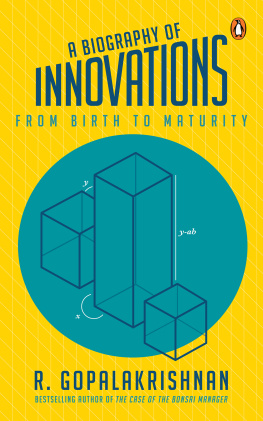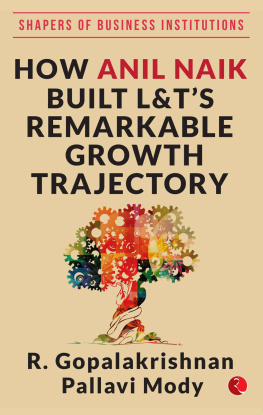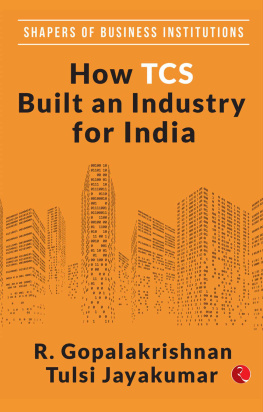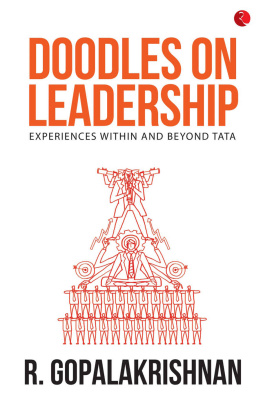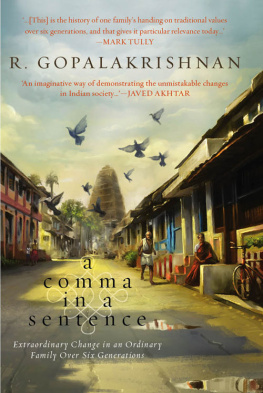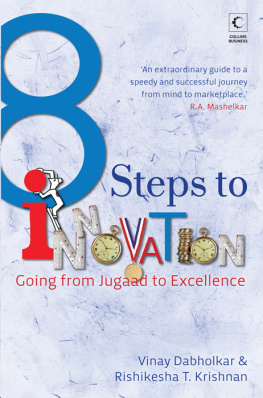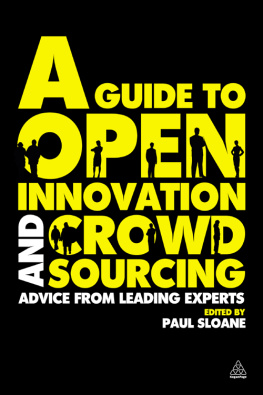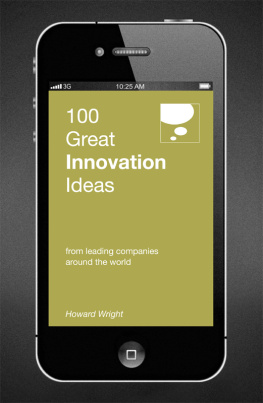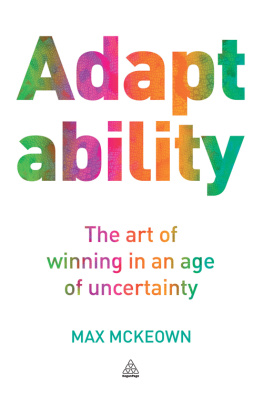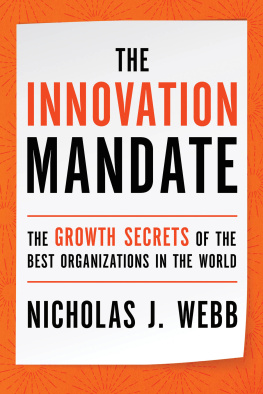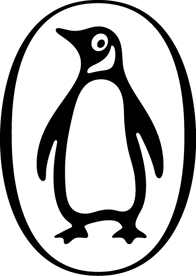Preface
I nnovation has long fascinated me. Even though I never applied my mind to the subject in any serious way, and this attraction was a more general one, in 2004 my relationship with the subject changed.
My company, Tata Sons Limited, requested me to chair a Tata Group Innovation Forum (TGIF). My steering committee had a cross-company membership, strengthened with subject experts. Ratan Tatas mandate to the TGIF was to positively influence the culture of innovation more than the process of innovation in all Tata companies. It was a challenging mandate as culture is a fuzzy subject to grapple with, especially for a whole bunch of engineers. Further, the effects of ones actions are difficult to ascertain as compared to technical measurements.
This mandate changed the terms of my engagement with the subject of innovation. I chaired the TGIF for eleven years. Naturally, I had access to all the Tata companies which operate across a wide variety of technologies, domains and consumer spaces. These companies gave me enormous insight about technology, business models, ambitions, human behaviour and persistence.
During this period I read a veritable library of books on the subject and spoke to international companies like DuPont, GE, Honeywell and DSM to learn and share. I participated in the workshops and symposiums of institutions like Imperial College London, London Business School, Stanford University, The Economist and the Financial Times as well as Indian institutions of distinction, like the National Innovation Foundation, the Marico Innovation Foundation, the National Innovation Council and the Atal Innovation Mission.
The need to reflect and express my thoughts and observations was fulfilled in 2012 when I became a columnist for Business Standard. My monthly column, titled Innocolumn, was about innovation, entrepreneurship, creativity and allied themes. By the time this book is in print, I will have completed over fifty monthly contributions. All of these experiences have, in fact, inspired me to write this book.
A casual inquisitiveness about what happens in the human brain during the process of thinking, or the way in which it works, was an important part of my journey. If the reader finds the initial chapters somewhat rich with this laymans version of insights on neuroscience, my immense curiosity about the brain may be blamed.
It is this curiosity that led me to read about Michael Merzenich, who has done a great deal of work on the plasticity of the brain. He says that the brain is plastic, in the sense that it assumes the form of the influences it is subjected to. The surface area of the brain has been likened to real estate by calling it cortical real estate. I learnt that the brain does not waste any cortical real estate and any new learning occupies brain real estate. The more a learning is practised, the deeper that learning imprints itself on to the plastic brain.
This is a bit akin to how pathways get formed on mountain trails. New pathways dont come up easily, but the repeated use of any pathway strengthens it into an oft-used pathway. I learnt that in the five cups of tofu-like tissue inside the head, nestled amongst a trillion support cells, some 100 billion neurons are signalling to one another in a network with about half a quadrillion connections called synapses.
The learning itself may produce bad or good habits. There is a competitive plasticity in the brain to accommodate learnings of the individual. This also teaches us that not only is learning embedded in the brain, but that the brain itself is learning to learn! Amazing, isnt it? Thus, it is our habit and desire to learn, to be curious, that influences brain plasticity.
Providing me contemporary evidence was a report about John B. Goodenough. He set the technology industry ablaze at the age of ninety-four. He and his team at the University of Texas, Austin, filed a patent application on a new kind of battery that if it works as promised, would be so cheap, lightweight and safe that it would revolutionize electric cars. Thirty-seven years earlier, when he was fifty-seven years old, Goodenough had co-invented the lithium-ion battery.
My contemporary at the Indian Institute of Technology Kharagpur, Prof. Anjan Bose, who is a regents professor of power engineering at the School of Electrical Engineering and Computer Science at Washington State University, confirmed that age is no impediment to new learning, though motivation and determination can become impediments.
Bose, a great admirer of Goodenough, had the privilege of studying and advocating why the latter should be considered the father of lithium-ion batteries. Bose had served for several years on the committee that awards the Draper Prize, an American prize given through the United States National Academy of Engineering to technologies that have changed global society. The technologies are easy to identify and it is the committees responsibility to identify the people behind them. Often, major technologies like the cell phone have dozens of key contributors. The Draper Prize, however, is given only when the key contributors are five or less.
In 2014, the Draper Prize was given to two academics and two corporate researchersGoodenough, Rachid Yazami, Akira Yoshino and Yoshio Nishi. Goodenough was the first to make a Li-ion battery work in his lab and he is the only one still doing full-time research. During his fact-finding on the Li-ion battery, Bose spoke with many who knew Goodenough well. People were quite awed by the fact that even at ninety-four, he attends conferences, presents papers and collaborates with other researchers. He could very well get the Nobel Prize, says Bose.
This view contrasts with the Silicon Valley obsession with young people, epitomized by Mark Zuckerbergs comment at Stanford University in 2007: Young people are just smarter. Author Pagan Kennedy writes, There is evidence to suggest that late blooming is no anomaly, quoting a 2016 study that shows that inventors peak in their late 40s and tend to be productive in the latter half of their careers. Nobel winners apparently make their discoveries at an average age of fifty.
It is important to note that age is not necessarily an impediment to being innovative, unless you have determined that to be so. What caught my attention was the evidence that from the time the innovator or scientist is born, it takes about forty to fifty years for him or her to peak and become truly productive. This goes against the generally held belief that for middle-aged people, great leaps of imagination are already well behind them.

